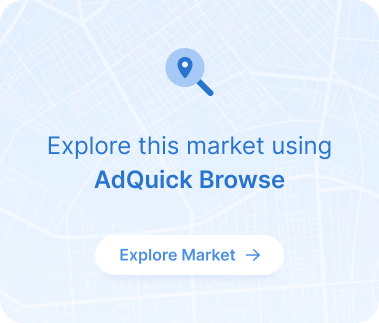Billboards in Charleston
*All metrics are based on a 4-week advertising campaign
In the charming coastal city of Charleston, outdoor advertising finds a perfect backdrop amidst its historic architecture, thriving tourism, and diverse neighborhoods. As a top destination for visitors and a hub for local culture, Charleston presents advertisers with a unique opportunity to engage audiences through billboards and other out-of-home media. Here, advertising transcends mere product promotion, fostering connections between communities, brands, and individuals, and weaving compelling narratives that captivate both residents and tourists alike.
What to look for when picking billboards
With 217 factors to consider when picking billboards to advertise on, it's essential to focus on the most critical aspects to ensure a successful campaign. Some key factors include:
- Location: Choose a strategic location that targets your desired demographic, maximizes visibility, and aligns with your campaign's intent. For example, a billboard near a busy highway would be ideal for reaching a large audience of commuters.
- Size: Select the appropriate size for your billboard based on its location and target audience. For instance, a large bulletin would be suitable for a highway, while a smaller junior poster might be more effective in an urban neighborhood.
- Duration: Determine the optimal duration for your billboard advertisement based on your campaign goals and budget. Some campaigns may benefit from a longer duration of six to twelve months, while others might be more effective with a shorter timeframe.
- Cost-effectiveness: Consider the cost of billboard advertising compared to other media and ensure it aligns with your budget. Billboards can offer a high return on investment and are often more affordable than television advertising.
Billboards price breakdown
In Charleston, the pricing of billboards varies significantly, providing advertisers with options to suit their budget and campaign needs:
- Average Price: The average price for a billboard in Charleston is $5,593.58, offering a range of options for advertisers with different budgets.
- Median Price: With a median price of $3,240, advertisers can find billboards that are more affordable than the average, while still reaching a sizable audience.
- Lowest Price: For those on a tight budget, the lowest price for a billboard in Charleston is $250, making it possible for even small businesses to take advantage of outdoor advertising.
Billboards Impression and CPM Metrics
In Charleston, the impressions and CPM metrics for outdoor advertising showcase the potential reach and cost-effectiveness of billboards in the area:
- Total Impressions: Charleston's outdoor advertising generates a total of 237,757,000 impressions, highlighting the vast audience that can be reached through billboards.
- Average Impressions: On average, a billboard in Charleston receives 1,449,000 impressions, demonstrating the consistent visibility of outdoor ads in the city.
- Median Impressions: With a median of 670,000 impressions, advertisers can expect a substantial number of views even for billboards with lower-than-average visibility.
- Average CPM: The average cost per thousand impressions (CPM) in Charleston is $229.55, offering a competitive rate for advertisers seeking to maximize their return on investment.
- Median CPM: At a median CPM of $4.92, advertisers can find even more cost-effective options for reaching their target audience in Charleston.
Some of the top billboard providers in Charleston
Charleston is home to several top outdoor advertising providers, each offering unique services and solutions to help businesses reach their target audience effectively:
- Adams Outdoor Advertising emphasizes the power and relevance of outdoor advertising in the digital age, leveraging big data to enhance the effectiveness of their campaigns.
- Fairway Outdoor Advertising is a leading provider of outdoor advertising solutions, offering a wide range of billboard options to suit various campaign needs and budgets.
- Renfroe Outdoor Advertising specializes in combining billboards and digital media to meet advertising needs effectively.
- Lamar Advertising Company specializes in outdoor advertising, offering services in billboard, digital, transit, and airport advertising to help businesses reach their audience effectively.
- OUTFRONT leverages the power of location, creative, and smart audience data to drive meaningful connections between brands and audiences in the real world with out-of-home advertising.
Other formats for advertising in Charleston
A closer look at the data reveals the depth and breadth of the other opportunities available in Charleston:
- Digital Billboards: In Charleston, digital billboards receive 28,000 impressions with an average CPM of $95.96. This modern and dynamic medium allows for real-time updates and eye-catching visuals, making it a popular choice for advertisers seeking to stand out.
- Wheat Pastings: Wheat pastings in Charleston generate 1,000 impressions and have an average CPM of $11,107.01. This unconventional and artistic form of advertising can create a buzz and leave a lasting impression on viewers, especially in urban areas.
- Retail Venues: Advertising in retail venues in Charleston garners 28,000 impressions with an average CPM of $29.65. This targeted approach allows advertisers to reach consumers in a shopping mindset, increasing the likelihood of conversions.
- Transit: Transit advertising in Charleston achieves 6,000,000 impressions and an average CPM of $9.86. This highly visible medium targets commuters and travelers, providing repeated exposure to a captive audience.
- Everything Else: Other advertising opportunities in Charleston collectively receive 747,912 impressions and have an average CPM of $9.90. These diverse options allow advertisers to explore unique and creative ways to reach their target audience in the city.
Get started with advertising with AdQuick now!
AdQuick simplifies the out-of-home advertising process by combining technology, expertise, and data to offer a comprehensive suite of tools for efficient ad buying globally. With immediate access to over 1,400 premium OOH media owners, advertisers can launch campaigns in as little as 48 hours and enjoy measurable outcomes. By signing up, you'll gain access to industry-leading technology, the ability to browse and connect with 99% of billboard ads and media owners nationwide, guaranteed best billboard prices, and white-glove service for campaign planning and execution. Don't miss out on the opportunity to elevate your advertising game – sign up for AdQuick today!
